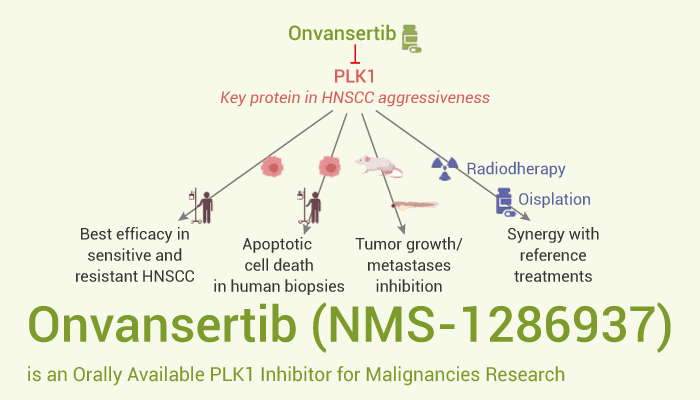Onvansertib, a PLK1-specific ATP competitive inhibitor, blocks the phosphorylation of PLK1 substrates.
Polo was first identified in Drosophila melanogaster. The family of polo-like serine/threonine kinases includes 5 members: PLK1, PLK2, PLK3, PLK4 and PLK5. Firstly, PLK1 comprises a C-terminal polo-box domain. And PLK1 activates 622 substrates during the different steps of the cell cycle. Besides, it controls centromere maturation, mitosis entry, chromosome segregation and cytokinesis. Meanwhile, it plays a key role in the DNA damage checkpoint. And it is an essential actor of cell proliferation and maintenance of genomic stability. This major role in cell proliferation appears relevant to stop tumor progression by specific inhibitors of PLK1. Furthermore, The depletion of PLK1 in cancer cells resulted in cell cycle arrest, polyploidy, and apoptosis.

Onvansertib is a potent, selective and orally available PLK1 inhibitor with an IC50 of 2 nM.
In vitro, Onvansertib (NMS-1286937) shows inhibitory activities against FLT3, MELK, and CK2 with IC50s of 510, 744, and 826 nM, respectively. Meanwhile, NMS-P937 (10 μM) is selective with a marginal activity of 48% and 40% inhibition on PLK2 and PLK3, respectively. Furthermore, NMS-P937 shows antiproliferative activity with IC50 values of below 100 nM for 60 of 137 cell lines. In addition, NMS-P937 shows cytotoxic activity against AmL-NS8 cells with IC50 of 36 nM.
In vivo, NMS-1286937 (45 mg/kg, i.v.) shows a good tumor growth inhibition with acceptable and reversible body weight loss in CD1 nu/nu mice xenografted with human HCT116 colon adenocarcinoma cells. On the one hand, NMS-1286937 (60 mg/kg, p.o.) also inhibits the growth of tumor on HCT116 xenograft model. On the other hand, the combination of NMS-P937 and cytarabine in the disseminated leukemia model AmL-PS is well tolerated and clearly shows increased mice survival. In addition, NMS-P937 (60 mg/kg bid per day over 2 days with a 5 day rest) shows good efficacy. It has a significant increase in median survival time (MST) in the established disease setting.
Reference:
[1] Hagege A, et al. Theranostics. 2021 Sep 21;11(19):9571-9586.
[2] Beria I, et al. Bioorg Med Chem Lett. 2011 May 15;21(10):2969-74.